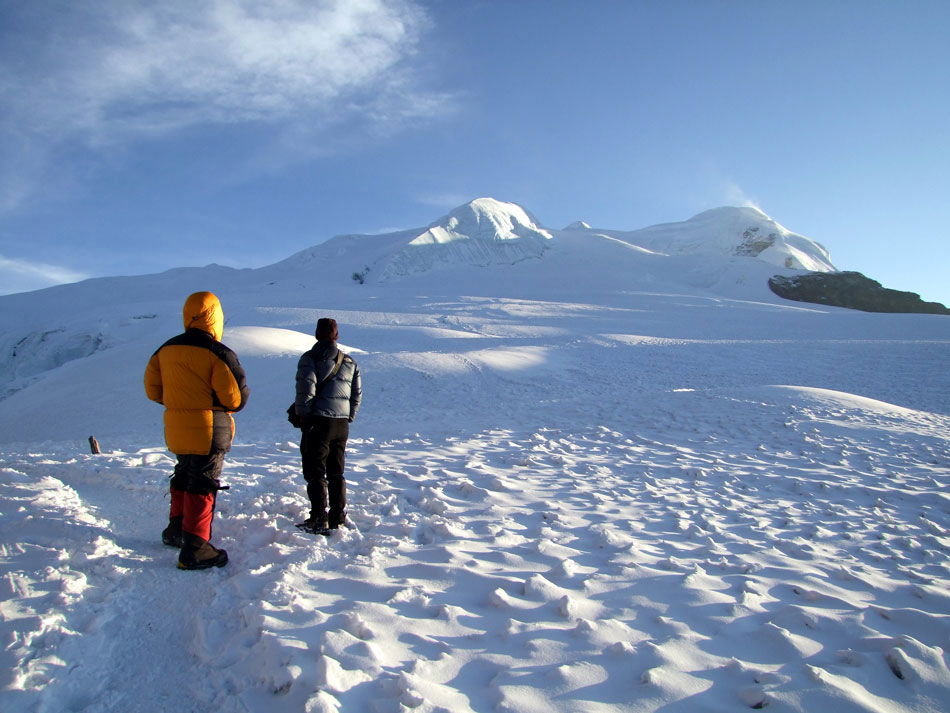Mera Peak Trek and Climbing at Cheap and Affordable Cost
Trip Overview
Ever dreamed of standing on top of the world, surrounded by Himalayan giants like Everest, Lhotse, and Makalu? That dream can come true with Mera Peak Trek and Climbing—a perfect blend of adventure, altitude, and awe. This journey isn’t just for hardcore climbers; it’s also within reach of determined trekkers ready to push their limits. If you’ve got a sense of adventure, a bit of training, and a love for mountains, Mera Peak could be your next big goal. Imagine the trek like a long, beautiful symphony—each day a new note, rising slowly in intensity until the final crescendo: the summit. Let’s dive deep into this unforgettable Himalayan experience.
What is Mera Peak?
Mera Peak is a highest trekking peak in the Mahalangur section of the Himalayas, standing at an impressive 6,476 meters (21,247 feet). Though high, it’s considered a non-technical climb, which means it doesn’t require advanced mountaineering skills. That’s what makes it so popular—especially for first-time climbers wanting a true Himalayan summit.
Where is Mera Peak Located?
Mera Peak is nestled in the Solukhumbu region of Nepal, just east of the famous Everest Base Camp trail. The journey begins with a thrilling flight to Lukla, followed by a quieter, more remote trek through dense forests, alpine valleys, and picturesque Sherpa villages. It’s off the beaten path, offering peaceful trails and spectacular mountain views.
Why Choose Mera Peak for Your First Climb?
Mera Peak is the gateway to Himalayan mountaineering. Here’s why it’s a favorite:
- Stunning 360° Summit Views: From the top, you can see five of the world’s six highest mountains.
- Low Technical Barrier: Requires basic rope use and ice axe/crampons, but no hardcore climbing.
- Less Crowded Trail: A serene experience compared to Everest or Annapurna routes.
- Great Acclimatization Opportunity: The trek offers a gradual ascent, reducing altitude risks.
- Think of it as the “training wheels” of mountaineering. It manageable with the right mindset.
Mera Peak Trek and Climbing Route Overview
There are two main routes to Mera Peak:
A. Standard Scenic Route via Paiya and Pangom
- A bit longer and easier acclimatization
- Passes through lush forests and fewer steep ascents
- Most people follow this route
B. Short Route via Zatrwa La Pass
- Starts with a flight to Lukla
- Crosses Zatrwa La Pass (4,610m) early on
- Joins the traditional Mera trail at Khote
Mera Peak Trek and Climbing Itinerary (17 Days): Standard Scenic Route
Day 1: Arrive in Kathmandu (1,400m/4,593ft)
Arrive at Tribhuvan International Airport, transfer to a hotel in Thamel.
Attend a trip briefing and gear check. Prepare for the trek (e.g., purchase or rent gear).
Overnight in Kathmandu.
Day 2: Fly to Lukla (2,860m/9,383ft), Trek to Paiya (2,730m/8,957ft)
Early morning flight to Lukla’s Tenzing-Hillary Airport.
Meet porters and Sherpa guides, begin trek (3–4 hours) through lush forests and Sherpa villages.
Descend along the Dudh Koshi River, cross suspension bridges, and arrive at Paiya.
Overnight in a teahouse at Paiya.
Day 3: Paiya to Panggom (2,846m/9,337ft)
Trek 5–6 hours through rhododendron and pine forests, crossing the Kari La Pass (3,145m).
Pass traditional Sherpa villages and enjoy views of the surrounding hills.
Overnight in a teahouse at Panggom.
Day 4: Panggom to Ningsow (2,863m/9,393ft)
Trek 4–5 hours through bamboo forests and along the Hinku Valley.
Cross streams and ascend gradually, with views of terraced fields and distant peaks.
Overnight in a teahouse at Ningsow.
Day 5: Ningsow to Chhatra Khola (2,800m/9,186ft)
Trek 6–7 hours, descending to the Hinku River and climbing through dense forests.
Pass Ramailo Danda for panoramic views of Mera Peak and surrounding ridges.
Overnight in a teahouse at Chhatra Khola.
Day 6: Chhatra Khola to Kothe (3,600m/11,811ft)
Trek 6–7 hours along the Hinku Khola River, entering Makalu Barun National Park.
Views of Mera Peak begin to emerge. Trail includes gentle inclines and riverbank paths.
Overnight in a teahouse at Kothe.
Day 7: Kothe to Thaknak (4,358m/14,297ft)
Trek 3–4 hours along the Hinku Khola, with gradual ascents through open valleys.
Pass evidence of the Sabai Tsho glacial lake collapse. Views of Mera Peak and Kusum Kanguru.
Overnight in a teahouse at Thaknak.
Day 8: Thaknak to Khare (5,045m/16,486ft)
Trek 3–4 hours to Khare, the last settlement before Mera Peak Base Camp.
Steep ascent with views of Kyashar and Mera’s north face. Enter glacial terrain.
Overnight in a teahouse at Khare.
Day 9: Acclimatization Day in Khare
Rest day to acclimatize at 5,045m.
Short hikes around Khare or to nearby hills for views and altitude adaptation.
Climbing guide provides training on mountaineering skills: using crampons, ice axes, harnesses, and ropes (e.g., self-arrest, clipping in/out).
Overnight in a teahouse at Khare.
Day 10: Trek from Khara to High Camp (5,800m)
Trek to High Camp via the Mera La Pass (5,415m). The trail involves glacier walking and rocky terrain and also need to crossing snow slopes and glaciers. It takes 6/7 hours. Overnight in tents at High Camp.
Day 11: Summit Mera Peak (6,476m/21,247ft) and Descend to Khare
Start at 2–3 a.m. for a 6–7 hour ascent to the summit, using fixed ropes and Sherpa guidance.
Summit offers panoramic views of Everest, Lhotse, Cho Oyu, Makalu, and Kanchenjunga (weather permitting).
Descend 3–4 hours to Mera Base Camp, then continue to Khare (total 10–12 hours).
Overnight in a teahouse at Khare.
Day 12: Khare to Kothe (3,600m/11,811ft)
Trek 6-7-hours. Overnight in a teahouse at Kothe.
Day 13: Kothe to Thuli Kharka (4,300m/14,107ft)
Trek 6 hours, descending along the Hinku Khola and ascending to Thuli Kharka.
Pass through forests and enjoy views of the Hinku Valley.
Overnight in a teahouse at Thuli Kharka.
Day 14: Thuli Kharka to Lukla via Zatrwa La Pass (4,600m/15,091ft)
Trek 6–7 hours, crossing the challenging Zatrwa La Pass with views of the Hinku wilderness and Numbur Himal.
Descend to Lukla, returning to the bustling Sherpa town.
Overnight in a teahCHAPTER 1: INTRODUCTION house at Lukla.
Day 15: Fly from Lukla Kathmandu or Ramechhap
Morning flight to Kathmandu or Ramechhap, weather permitting.
Transfer to hotel in Kathmandu. Free afternoon to relax or explore.
Overnight in Kathmandu.
Day 16: Buffer Day/ Free day.
Reserved for bad weather. Overnight in Kathmandu.
Day 17: Depart Kathmandu
Transfer to Tribhuvan International Airport for departure.
MERA PEAK TREK AND CLIMBING COST
| IN THE AUTUMN SEASON (OCT, NOV) | USD 1970 Per Person |
| IN THE SPRING SEASON (APR, MAY) | USD 2095 Per Person |
The above Package Cost includes:
• On your arrival day, airport pickup service by car.
• 3-night accommodation in Kathmandu at Tourist Standard Hotel with breakfast (1 night before the trek and 2 night after the trek).
• Air Tickets for Lukla Flights.
• Airport tax on Lukla flights.
• 12-night accommodation in Tea House during trekking.
• 1-night accommodation in a tented camp.
• 3 Meals (breakfast, lunch, and dinner) in a day during the trek and climbing.
• One experienced trek Guide and climbing Sherpa for climbing.
• Porter for the entire trekking. (As a practice, the porter will be provided based on one porter sharing by two trekkers. According to the rule, one porter carries the luggage of two trekkers with a total maximum weight limit of 25 kg).
• Expenses for food, accommodation, insurance, transport, and the wages of trekking staff.
• Trekking Permit (TIMS Card).
• Makalu Barun National Park fee.
• Khumbu Ganu Palika Permit fee.
• Mera Peak climbing permit fee.
• Climbing equipment like ice axe, Ice crew, snow bar, Ice Hammer, and climbing rope.
• Camping gear like two men’s tent, kitchen tent, kitchen equipment, and mattress while climbing period.
• All ground transport types as mentioned in the itinerary.
• Altitude medicines, Oximeter, first aid medicines.
• Map of the Trekking route.
• Trip Achievement Certificate.
• Duffel Bag to keep your trekking stuff.
• All government taxes, local taxes, and tourist service charges.
• On your departure day, airport drop service by car.
The above Package Cost does not include the following:
• Airfare for your international flight.
• Nepal Visa Fee.
• Your travel insurance which includes high-altitude helicopter evacuation and medical (It is advised the insurance should cover high-altitude emergency rescue, evacuation & medical.).
• Alcoholic beverages, any hot and cold drinks, hot water, bottled water, and dessert.
• Personal trekking and climbing gear (Climbing boot, Sleeping bag, down Jacket, etc.). You can rent them in Kathmandu and Khare.
• All kinds of personal expenses like phone calls, internet use, laundry, battery charge, hot- shower during trekking, excess baggage charge on Lukla flight, etc.
• Lunch and dinner in Kathmandu, except for farewell dinner on the last night of the trip.
• In case of emergency helicopter rescue/ evacuation & its cost.
• Tips for Trekking Staff.
• Any expenses arising from natural calamities, mishaps, personal sickness, flight cancellation, political strikes, or anything beyond our control (Costs are not refundable and non-transferable if you leave the trek and climbing voluntarily and want to return from the trek earlier than scheduled).
• Cost of any extra services, if you use, which are not mentioned in the above package, includes section.
Note:
• The above price is on a per-person basis for a minimum group size of 2 people. We also organize Solo Mera Peak Trek and climbing. For the solo trip, a single supplement charge will be applied. Please contact us for the price of the Solo Trip.
Excellent Himalaya Trek and Expedition is leading operator of Mera Peak Climbing. For any further information, or any questions, please contact us by email at [email protected] or WhatsApp at +9779851203181.
Best Time for Mera Peak Expedition
Timing is everything in the mountains. The best seasons for Mera Peak Trek and Climbing are:
Spring (March to May): Stable weather, blooming rhododendrons, longer days
Autumn (September to November): Clear skies, dry trails, and fantastic visibility
Avoid winter due to freezing temperatures and snowstorms, and monsoon because of heavy rain and landslides.
How Difficult is Mera Peak?
Here’s what makes it challenging:
High Altitude: The air gets thin above 5,000m
Glacier Walks: Using crampons and walking on ice
Long Days: The summit day can last 10-12 hours
It’s a test of endurance, determination, and preparation—but absolutely doable for fit trekkers.
Altitude Sickness & Acclimatization
One of the big hurdles on this trek is Acute Mountain Sickness (AMS). Here’s how to stay safe:
Take it Slow: Gradual ascent is key
Hydrate Regularly: Water helps your body adjust
Follow the “Climb High, Sleep Low” Rule
Include Rest Days: Especially at Khare
Don’t ignore symptoms like headaches, nausea, or dizziness. Descend if they worsen.
Physical Fitness & Training Tips
Mera Peak isn’t a walk in the park. Begin training at 2/ 3 months before your trek:
Cardio: Hiking, running, cycling—aim for endurance
Strength Training: Focus on legs and core
Practice Hikes: With a loaded backpack
Altitude Exposure (if possible): Try high-altitude hiking before your trip
Consistency beats intensity. Train like you’re preparing for a long-distance hike… because you are!
Packing List and Gear Recommendations
Clothing:
Base layers (thermal)
Insulated jacket (down)
Waterproof shell
Trekking pants & gloves
Woolen hat & buff
Climbing Gear (can rent in Kathmandu or Khare):
Mountaineering boots
Crampons
Ice axe
Harness
Helmet
Jumar (ascender)
Carabiners & ropes (provided by guides)
Don’t forget sunglasses, sunscreen, lip balm, and energy snacks.
Cultural Experiences on the Trek
Mera Peak isn’t just a climb—it’s a cultural immersion. Along the way, you’ll meet Sherpa communities, visit Buddhist monasteries, and witness traditional yak herding.
Take time to learn a few Nepali greetings, try butter tea, and spin a few prayer wheels for good luck.
Environmental Considerations
Let’s keep the Himalayas beautiful:
Pack Out Trash: Bring your waste back
Avoid Single-use Plastics
Stay on Trails: Prevent erosion
Respect Wildlife: No feeding or disturbing
Travel like a guest, leave no trace behind.
Final Thoughts & Preparation Checklist
Mera Peak is more than just a trek—it’s a journey to your inner strength. It challenges your body and uplifts your spirit. With the right mindset, gear, and guidance, you’ll not only reach the summit but also discover something new about yourself.
Quick Checklist:
Passport & Visa
Training Plan
Essential Gear
Travel Insurance (with rescue coverage)
Positive attitude!
Frequently Asked Questions (FAQs)
1. Do I need prior climbing experience for Mera Peak?
Not necessarily. Mera Peak is ideal for beginners with good fitness and basic training in using ice axes and crampons.
2. How long does the Mera Peak Trek and Climbing take?
Typically, it takes around 17 days with acclimatization day.
3. What are the risks involved in Mera Peak climbing?
Main risks include altitude sickness, cold weather, and glacial crevasses. With a guide and preparation, these can be managed.
4. Can I rent climbing gear in Nepal?
Yes! Most climbing gear can be rented in Kathmandu or Khare, saving you the trouble of buying everything new.
5. What’s the success rate of Mera Peak climbs?
With proper acclimatization and guide support, success rates are around 85-90%.






